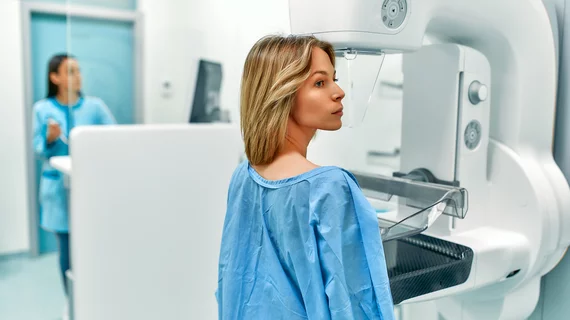Continued declines in screening mammogram volumes could have 'worrisome implications,' experts warn
More than three years after the height of COVID, the volume of screening mammograms still has not returned to pre-pandemic levels, according to new data out of Brigham and Women’s Hospital.
A group of experts from the hospital recently analyzed screening trends there in the years leading up to and following the onset of COVID. They observed a persistent decrease of five screening mammograms per month beginning in June of 2021. In contrast, between October 2016 and March 2020, the group noted a steady increase of 65 screenings per month.
As with most COVID-related impacts, some patients were more affected than others. The decline was seen in every age category below 70 and across all insurance types, but the downward trend was most notable in women who have at least one risk factor of severe COVID, the group explained.
“Mammography screening volume decline[s] especially affected those with risk factors for severe COVID-19, as we saw significantly different trends between the two subgroups,” study corresponding author Allyson L. Chesebro, from the Department of Radiology at Brigham and Women’s, and colleagues noted. “This may be because the fear of contracting COVID-19 outweighs the fear of a breast cancer diagnosis.”
The group’s findings also highlighted a shift in screening locations, with outpatient clinic screenings increasing from 35.8% prior to COVID to just under 45% in the years following.
"Given the census of COVID-19 patients in the hospital, screening mammography patients initially may have perceived the hospital as unsafe,” the experts suggested, adding that patients, especially those with COVID risk factors, might feel that they are less likely to contract the virus in an outpatient setting where COVID patients are not being treated.
Combined, the study’s findings could present an opportunity to improve screening rates, the authors said.
First, considering the increase in outpatient screenings over the last two years, the group suggested that expanding operating hours at hospitals’ outpatient imaging facilities could prompt patients to return for their annual mammogram. Second, in the presence of widespread vaccination and declining COVID cases, targeted outreach efforts that emphasize safe clinical environments should be made as a means of encouraging women to undergo routine screening.
While the long-term effects of declining screening mammogram rates are not yet fully understood, the group cautioned that there could be “worrisome implications for the future of breast cancer diagnosis and treatment” to come if rates do not improve.
The study abstract is available in Clinical Imaging.

